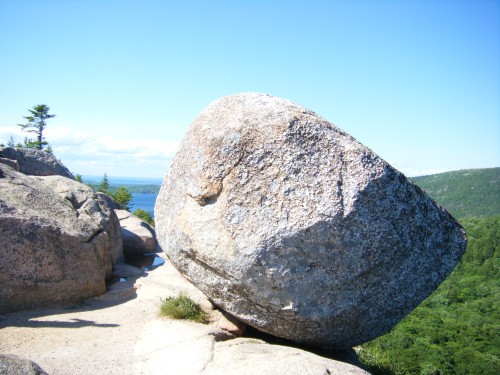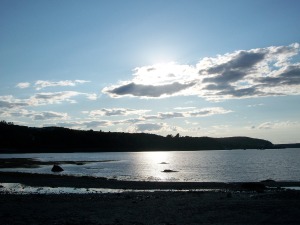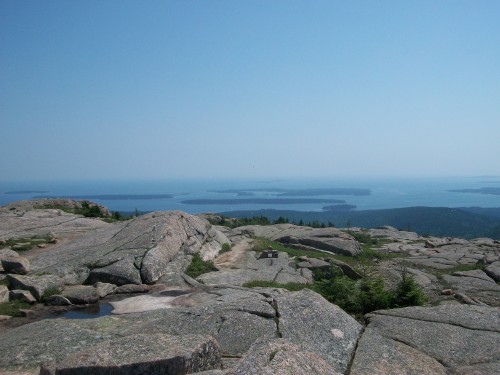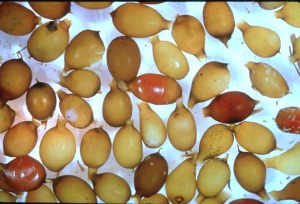
Joanna Carey is conducting her silica research at Babson Creek. Don't let the marsh's seemingly lack of fine sand particles fool you! The marsh is full of silica (L.Weisenfluh/ July 2010).
Its that time of the year again–summer time, or as I like to call it–vacation time (booyah!). After weeks of careful planning, you manage to take a few weeks off from work and head to your favorite lake house for some well needed vacation time. However, upon arrival to your lake house, you gape in horror as you see that your beloved vacationing spot has turned a murky green. That’s right–no swimming for you. In an outrage, you demand to know why your beloved vacation spot has turned a ghastly green. The answer lies in a phenomena that is known as eutrophication.
Eutrophication is the result of nutrient run-off from human industries, including fertilizer from farming activities. After fertilizing the plants, the fertilizer will find itself in some nearby lake or pond. And because these nutrients function as a food source for phytoplankton, phytoplankton will dramatically increase in numbers, thus turning the body of water into an unhealthy green color. While the phytoplankton is flourishing, other organisms will perish due to the lack of oxygen and sunlight.
When I personally think of nutrient run-off, I have been automatically trained to relate it to nitrogen and phosphorus (the most widely studied nutrients when it comes to eutrophication). But thinking about eutrophication just in terms of nitrogen and phosphorus completely ignores the fundamentals of ecology–that is, that everything is connected. In fact, nitrogen and phosphorus are just tiny parts of the ecological equation, yet receive most of the scientific attention. Nitrogen and phosphorus must be interacting with other chemicals that receive far less scientific attention. How about… silica, or instance?

Now that's a sandy beach! A shot from back home, Point Reyes, California (L. Weisenfluh/ August 2009)
Most people know silica for its presence on beaches in the form of small quartz pieces–sand. But silica isn’t just found on beaches, but other bodies of water, such as marshes. In fact, the presence or absence of silica is very influential in an ecosystem. Silica provides organisms with protection from desiccation and predation through its hardening capabilities. Diatoms (phytoplankton algae) use silica to maintain their cell walls; diatoms will actually bloom according to the availability of silica. Under normal circumstances, silica will be found in a 1:1 ratio with nitrogen in an ecosystem, meaning that, under this ratio both diatoms and nitrogen-feeding phytoplankton will live harmoniously in balance (relatively speaking, of course). However, when the silica to nitrogen ratio is less than one, silica concentrations will be low and not able to sustain a high diatom population, thus allowing non-silica limited algae (i.e. nitrogen-limited algae) to bloom and out compete diatoms. This results in rather nasty business for the environment, including eutrophication and red tides.
Because silica has this important regulatory role in an ecosystem, scientists are very interested in learning more about silica, hoping that it might give them some insight pertaining to eutrophication. However, we must address another concern before we can even venture to explore these implications: we have very little idea as to how silica travels through an ecosystem. Therefore, before we can even start to hash out implications of these correlations, we must determine something called a silica budget.
No, I am not talking about money. Rather, I am using the term “budget” in a purely ecological sense. When an ecological talks about a “budget”, he/she is referring to an attempt to quantify the distribution of particular elements (silica, in this case) and how it is transported throughout an ecosystem. Ecologists make budgets for all types of nutrients—nitrogen, phosphorus—and yes, even silica. Thing is, there haven’t been any attempts to make a silica budget in Northern America. That is…until now. Joanna Carey, a PhD. Candidate at Boston University is attempting to create a silica budget for a coastal wetland within Acadia National Park (Babson Creek, anyone?), with the hopes that this information can ultimately be used to infer how silica affects the biogeochemistry of an ecosystem. And just how is this accomplished? Very carefully…

Researchers take silica measurements out of the PVC contained marsh samples. Before using these PVC pipes, researchers were measuring silica over a large marsh flume. However, water was moving too fast over the flume for an accurate measurement, therefore requiring researchers to use PVC pipes as a smaller flume enclosure (L.Weisenfluh/July 2010).
In her project, she is measuring two different types of silica: dissolved silica and particulate silica. Now, before the technicality of these terms chases you away, let me explain their significances: dissolved silica is silica that has yet to be used by organisms, and therefore indicates the amount of silica that is available for biological processes. Particulate silica (i.e. biogenic silica) is silica that has been hydrated (contains water), as a result of plankton biological processes. It can be found and measured in sediment and vegetation.
One can use these particulate and dissolved silica measurements to determine a silica budget. Both of these measurements are taken as water flows into large PVC tubes (a small replica of the larger marsh) under dark conditions (as to measure silica fluxes under non-photosynthetic processes, such as respiration). Researchers sample the water within these tubes for silica, phosphorus and nitrogen concentrations every 75 minutes for 5 hours.

Joanna Carey collects vegetation samples from the marsh by giving it a "haircut". By analyzing this vegetation sample back at the lab, she will be able to determine the amount of particulate silica found inside the vegetation.
The particulate silica can also be measured by examining silica concentrations in sediment and vegetation. This is done by taking sediment cores (you essentially core the marsh’s sediment, and then analyze this sediment for silica). Once the sediment is cored and extracted for measurement, researchers insert another tube into the marsh–a tube with dialysis membranes lining the outside edges of the tube. Dialysis membranes allow the salt water of the marsh to equilibrate with the water inside the dialysis tubes. Once the two environments have equilibrated their ion concentrations, researchers collect the dialysis tubes and analyze the samples to determine silica, nitrogen and phosphorus values. Researchers also take vegetation samples (of two widespread vegetation types—Spartina patens and Spartina alterniflora) and analyze their silica content back at the lab.
We shall see what the results of her research dictate… Ms. Carey is still in the process of carrying out her field work. But until then, don’t take that sand beneath your toes for granted–its small and unseemly presence is a part of something much greater and more important… rather an entire ecosystem.










